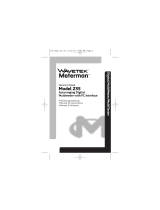
6
Anzeigesperre
HOLD Taste drücken um den Meßwert auf der Anzeige festzuhalten. Der
Meßwert bleibt erhalten, auch wenn die Meßspitzen vom Schaltkreis entfernt
sind. HOLD Taste erneut drücken um die Anzeige freizugeben.
Sicherheitsmeßkabel
Die Meßkabel haben versenkte Bananenstecker um elektrischen Schock zu
vermeiden. Die Meßspitzen sind zum Teil isoliert, um Kurzschlüsse in dichten
Schaltungen zu vermeiden. Diese Isolation kann entfernt werden.
Spezikatione
Allgemeine Spezifikationen
Anzeige: 3 1/2-stelliges LCD, 1999 Punkte, 0.7” (17.8mm) hohe Ziffern, Einheits-
und Funktionsanzeigen
Polaritätsanzeige: Automatisch, positiv unterstellt, negativ angegeben
Nullabgleich: AutomatischÜberlastanzeige: “OL” Entladene Batterieanzeige:
Batterie sofort wechseln.
Meßrate: 2.5 per Sekunde, nominal
Betriebstemperatur: 0°C bis 50°C, 0
bis 70% Relative Feuchte
Lagertemperatur: -20°C bis 60°C, 0 bis 80% R.F., Batterie entfernt.
Temperaturkoeffizient: 0.1 x (spez. Genauigk.) per °C (0-18°C, 28-50°C)
Stromversorgung: Standard 9-volt Transistorbatterie, NEDA 1604, JIS 006P, IEC
6F22
Automatische Abschaltung: nach 60 Minuten Inaktivität.
Batterielebensdauer (Typisch): 30 Stunden, Alkaline (ändert mit Funktion und
Anwendung)
Abmessung. (HxBxT): 18.3x7.9x3.8 cm
Gewicht (mit Batterie): 311 gr.
Zubehör: Meßkabel, 0.1A/250V Ersatzsicherung, Batterie, ein Paar
Krokodilklemmen, Anleitung.
Zulassungen: EMC
Dieses Produkt beantwortet an die Bestimmungen der folgenden EWG
Richtlinien: 89/336/EEC (Elektromagnetische Kompatibilität) und 73/23/EEC
(Niedrige Spannung) geändert durch 93/68/EEC (CE Marking).
Elektrisches Rauschen und starke magnetische Felder in der direkten
Umgebung des Meßgerätes können jedoch den Meßkreis beeinflussen.
Das Gerät kann auch durch Störsignale im gemessenen Schaltkreis
beeinflußt werden. Der Anwender muß Vorsichtsmaßnahmen treffen um
irreführende Meßergebnisse bei Messungen in der Umgebung von starken
elektromagnetischen Feldern zu vermeiden.
Elektrische Spezifikationen
Genauigkeiten bei 23°C ± 5°C, <75% R.F.
Widerstand
Bereiche: 20, 200Ω, 2, 20, 200kΩ, 2, 20MΩ
Auflösung, 20Ω Bereich: 10mΩ
Genauigkeit, 20Ω Bereich: ±1.2% vMW (Nullabgleich)






















